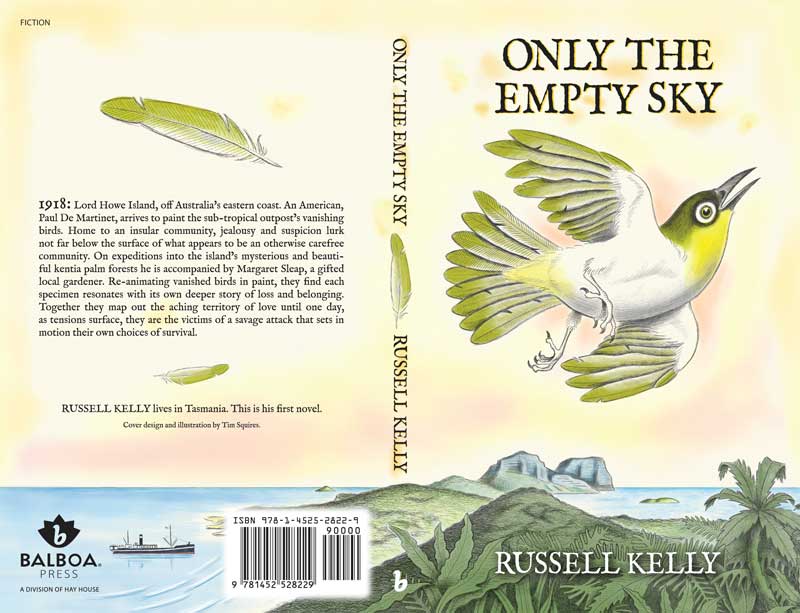
Tasmanian author Russell Kelly approached me to design and illustrate a book cover for his new novel Only The Empty Sky. I loved the story that Russell had written and quickly became very inspired by the challenge of producing a classical natural history style illustration to suite the tone of the text.
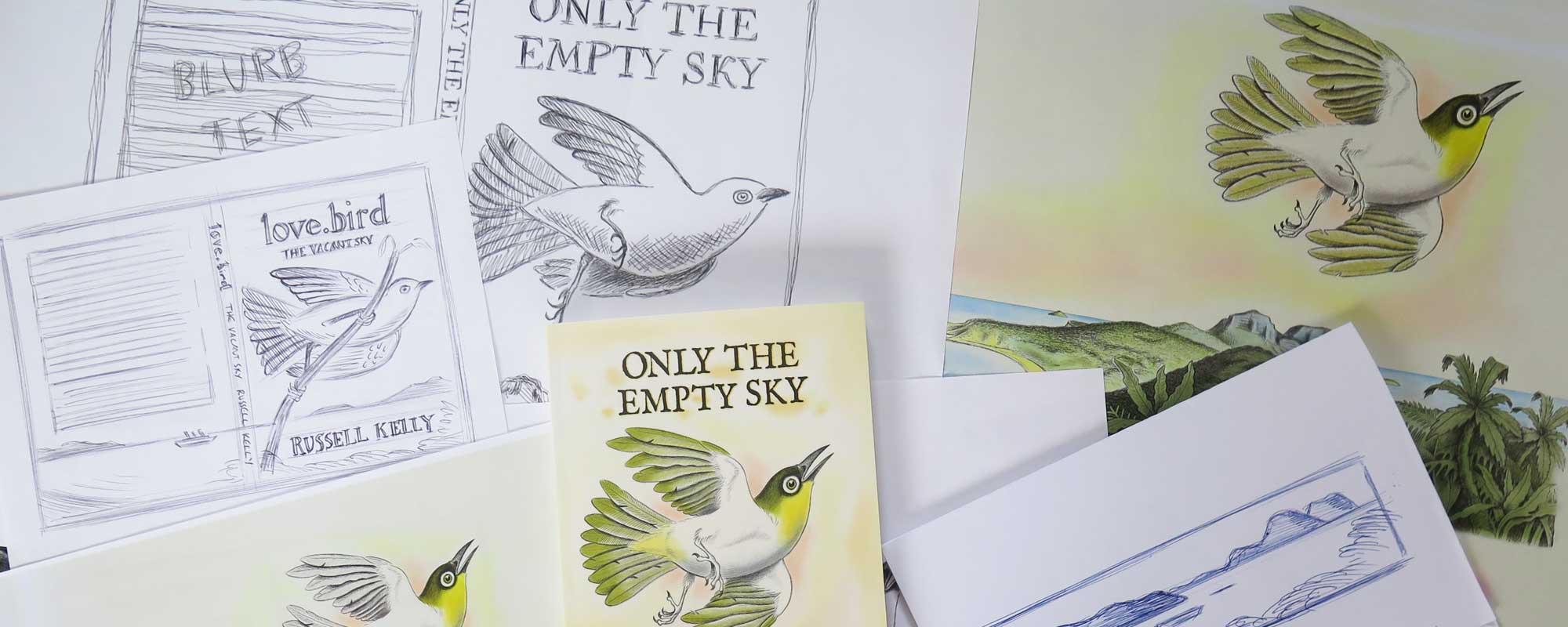
Developing the concept
Russell’s text is a beautiful tale about art, nature, love and loss. The challenge was to create an image that reflected the general themes within the book. It needed to represent fragility and the beauty of nature, but also be visually strong enough to hold its own in the competitive environment of busy bookstore shelves. Russell’s precis gave me a great starting point:
1918: Lord Howe Island, off Australia’s eastern coast. An American, Paul De Martinet, arrives to paint the sub-tropical outpost’s vanishing birds. Home to an insular community, jealousy and suspicion lurk not far below the surface of what appears to be an otherwise carefree community. On expeditions into the island’s mysterious and beautiful kentia palm forests he is accompanied by Margaret Sleap, a gifted local gardener. Re-animating vanished birds in paint, they find each specimen resonates with its own deeper story of loss and belonging. Together they map out the aching territory of love until one day, as tensions surface, they are the victims of a savage attack that sets in motion their own choices of survival.
Inspiration from existing books and images
Russell also showed me a book cover illustration that he really liked — a stunning piece of work by American artist Walton Ford whose work I have known and admired for many years. By coincidence I knew this particular book very well. The Song of the Dodo by natural history science writer David Quammen is one of my favourites, as is The Flight of the Iguana which also features a beautiful piece of watercolour artwork by Ford.
The influence of Audubon
The central character of the novel, Paul De Martinet, is an American naturalist who paints birds in the style of the nineteenth century master, John James Audubon. Russell needed the cover illustration to convey the same kind of reverence for nature that is shown in the works of Audubon, who was also famous for his ability to animate and give anthropomorphic qualities to his subjects. In the University of Tasmania’s art library there is a wonderful double-volume set of Audubon reproductions that served as terrific reference. I took the snaps above using my iPhone — they don’t do justice to the original watercolours, but they at least show the style of Audubon, and demonstrate his great talent.
In the University of Tasmania’s art library there is a wonderful double-volume set of Audubon reproductions that served as terrific reference. I took the snaps above using my iPhone — they don’t do justice to the original watercolours, but they at least show the style of Audubon, and demonstrate his great talent.
Developing presentation drawings
The working title for the novel at this point was love.bird. My idea was to show one of Lord Howe Island’s extinct bird species perched upon a branch with an island landscape in the background. As this was my first sketch, I wasn’t too concerned with anything other than conveying the essential idea.
 The bird that I chose was the Lord Howe Island White Eye, which became extinct soon after a steamer, the SS Makambo, ran aground on the island in 1918. There were many rats on board the ship and they were able to swim to shore and establish a breeding population that eventually decimated many native species on the island. As the SS Makambo is such a tragic part of Lord Howe Island’s history I felt that it was important to include it in the image.
The bird that I chose was the Lord Howe Island White Eye, which became extinct soon after a steamer, the SS Makambo, ran aground on the island in 1918. There were many rats on board the ship and they were able to swim to shore and establish a breeding population that eventually decimated many native species on the island. As the SS Makambo is such a tragic part of Lord Howe Island’s history I felt that it was important to include it in the image.
My second, more resolved sketch featured a view of Lord Howe Island that was much more accurate. Russell has also changed the title of the book to Only The Empty Sky. With the new landscape it also seemed more natural for the bird to be flying, rather than perched on a branch, and its presence in the sky seemed to reflect the new title more appropriately. This sketch was also made at the correct size and proportions required to fit the publisher’s printing format.
Creating the finished artwork
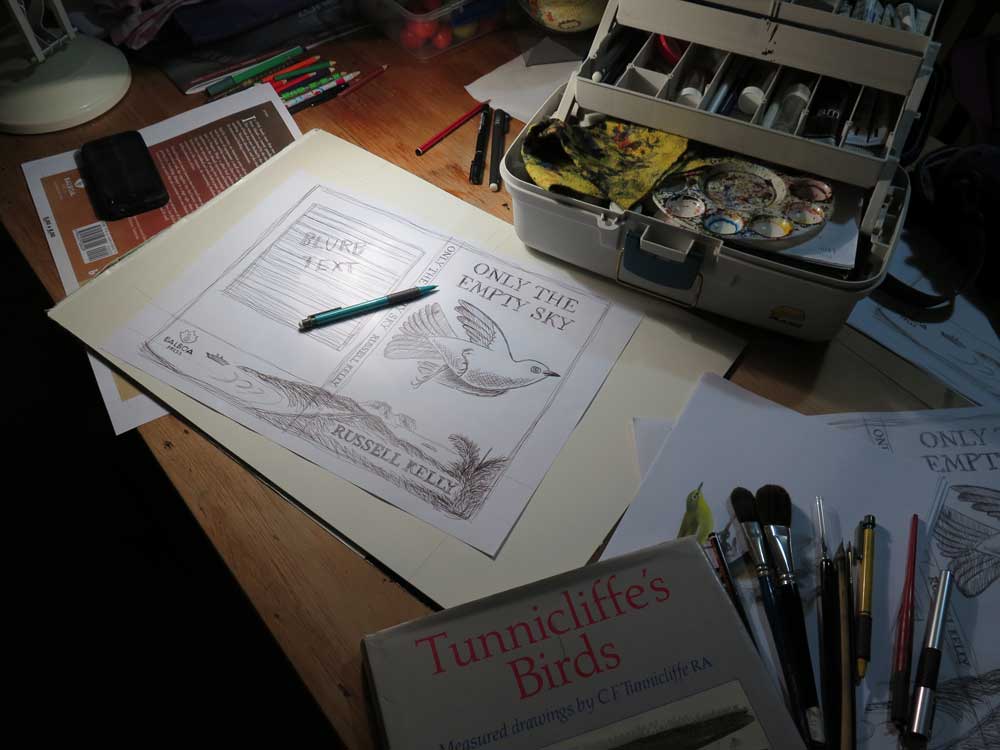
Next I set about transferring my working sketch onto a sheet of high quality watercolour paper to begin developing the finished artwork. This involved carefully refining the drawing as I went to make sure that all of the details were established before I committed to using my inks and watercolours.
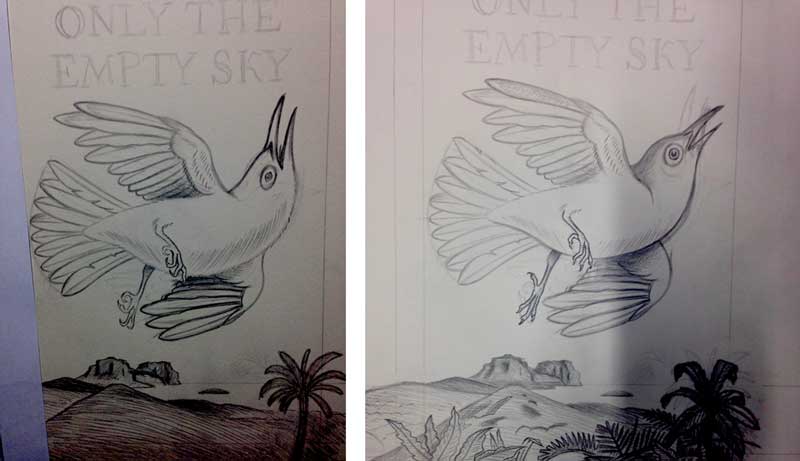
My first attempt, on the left, just didn’t feel right. I wanted to capture the fragility of a small vulnerable bird, but it was looking a bit too crow-like. After some more work I felt much happier with the bird’s expression, and I managed to create a much more gentle curve as the head blended into the body.
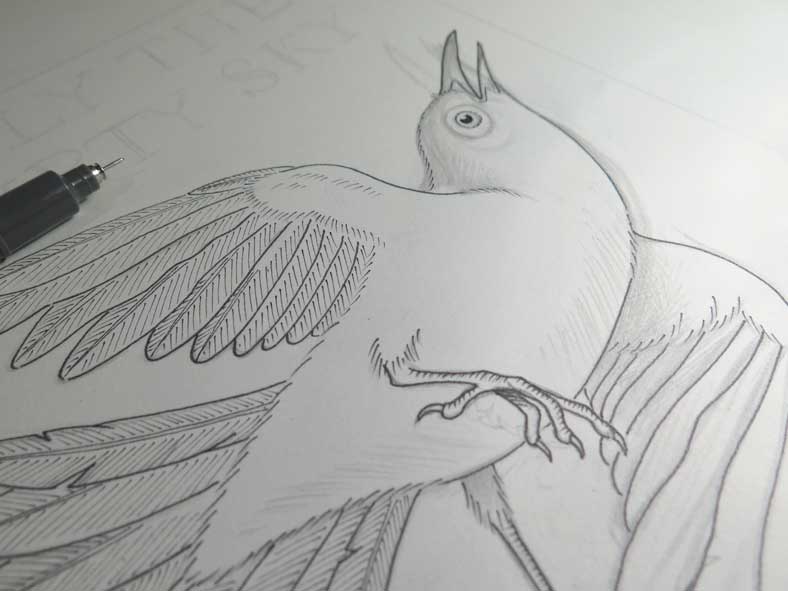
Next I applied waterproof ink over the pencil sketch so the lines could be painted over without smudging. I have used this technique a great deal in the past and so at this stage I was feeling happy with the way the work was progressing. Sadly, this would soon change.

I began to mix and apply my colours as usual, but after a while I started to realise that the drawing just wasn’t working. Even though I had used this very same technique extensively in the past, it simply didn’t feel right for this specific project.
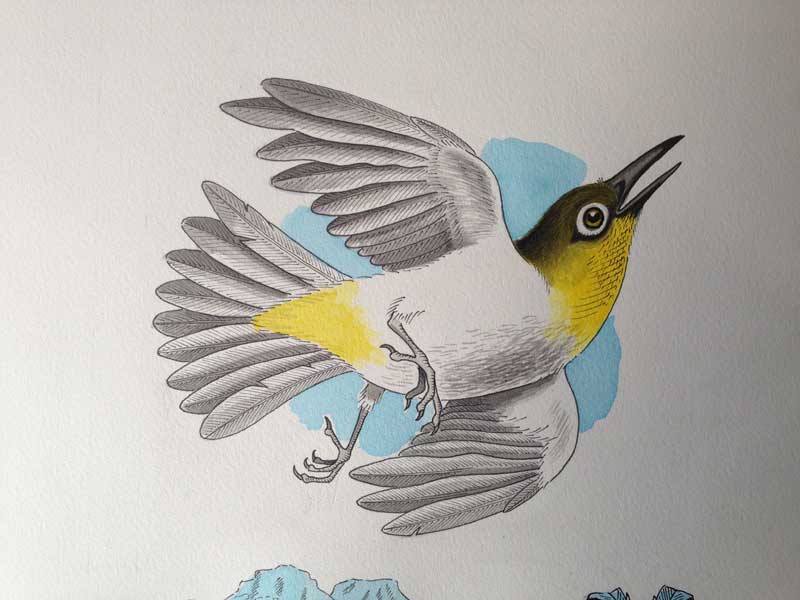
Even though I had used the finest pen that I could find, the line work was just too heavy, and my early washes of colour around the bird’s head felt muddy. The fragile, frightened expression of the bird that was present in the refined working drawing also seemed to have been diminished.

I decided to put that piece of artwork to one side for a while and began to experiment with a Wacom digital artwork computer (follow this link to see master artist and ex-Disney animator Aaron Blaise giving a Wacom Cintiq demonstration — scoot ahead to around the 18 minute mark of the video). Our staff cartoonist at the Mercury had been using a Wacom Cintiq for his artwork for a few years, and although I had experimented with it occasionally I hadn’t really appreciated its full potential. (I ended up being so impressed that I have since bought one for myself!) I began to feel more relaxed almost instantly, and the drawing began to flow and take shape in a much more positive way.
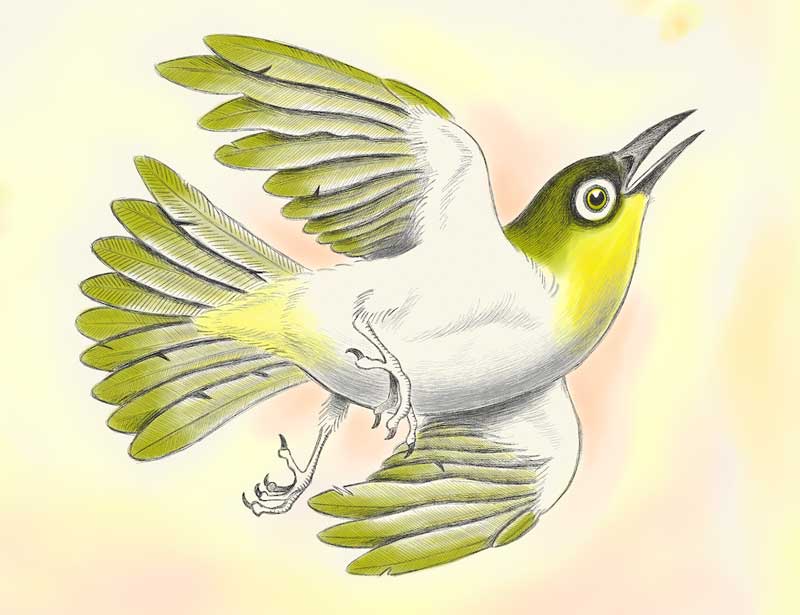
I was able to achieve a much lighter quality of line and also recapture the earlier expression that I had liked so much. The built-in colour palettes within the computer program allowed me to add and adjust soft washes of colour to emulate the foxed appearance of aged paper.

The additional fine control of the artwork and drawing tools within the program allowed me to work in refined detail, and also to make adjustments and corrections much more easily.
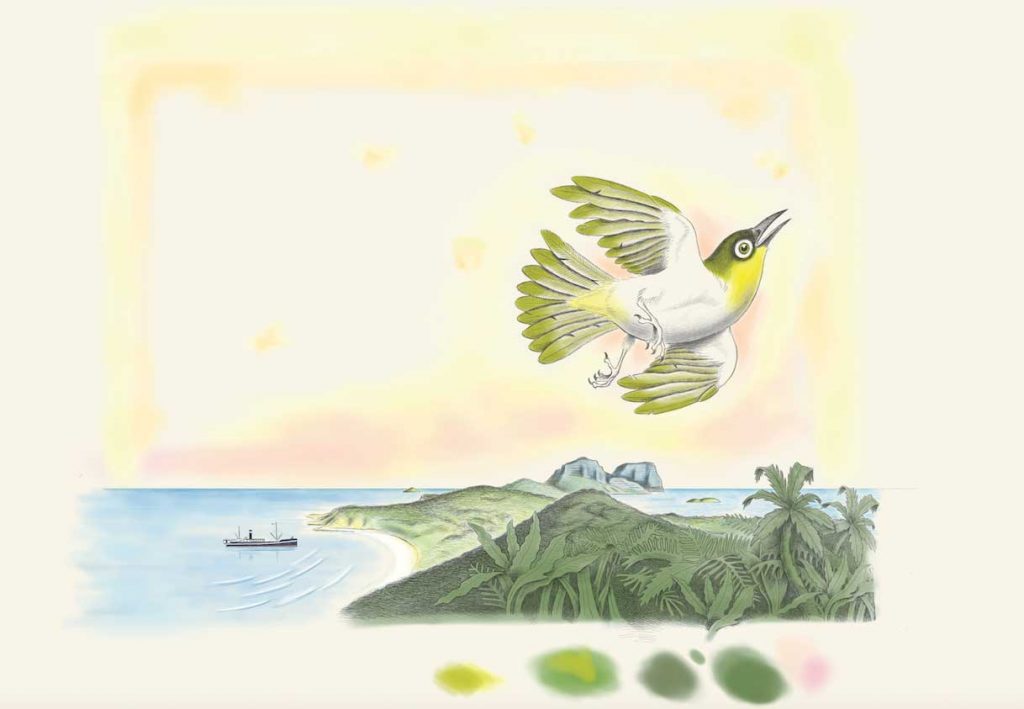
The final piece of artwork in its complete form is shown above. I left plenty of space around the margins to mix colours and experiment, but made sure that all of the critical components of the image were contained within the publisher’s measured specifications for printing, trimming and binding.

I imported the final digital artwork into Adobe Indesign where I was able to complete the layout, typesetting and preparation for printing. The finished, print-ready design was saved as a PDF with all necessary cropping and trim marks, and was then sent to the publisher via a Dropbox link.

I also used the image to illustrate Russell Kelly’s author website that I also designed for him to coincide with the launch of his new novel.

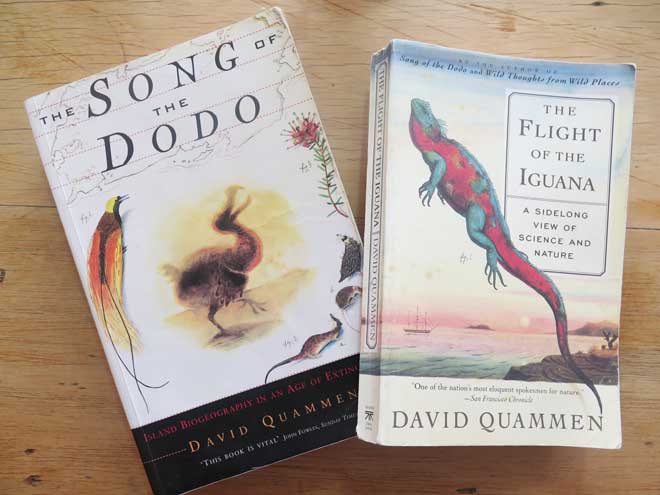

Great work!
Thanks very much, Oliver 🙂